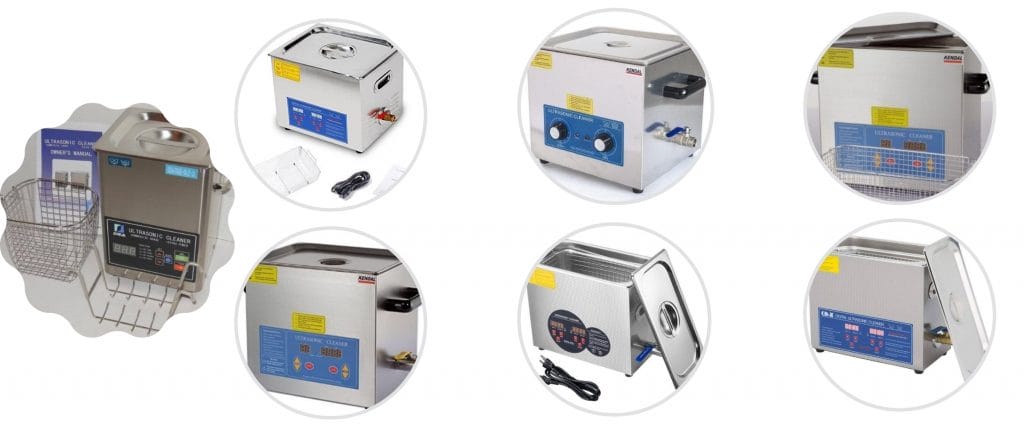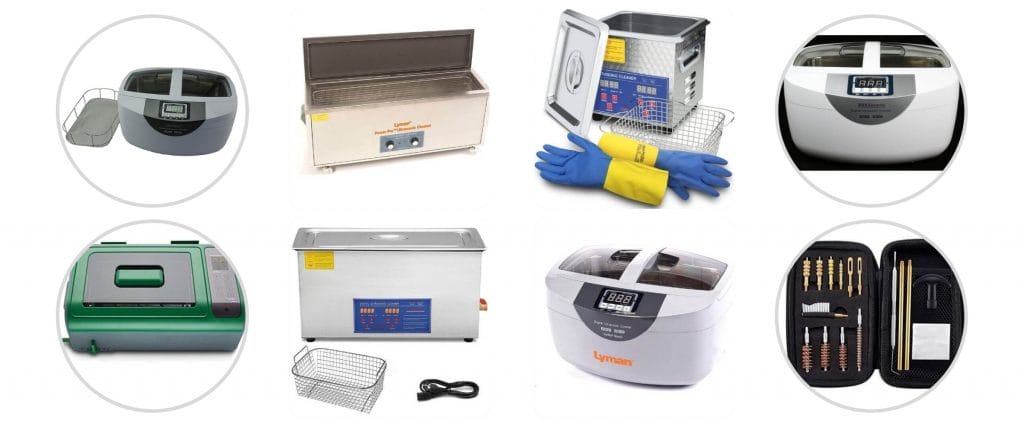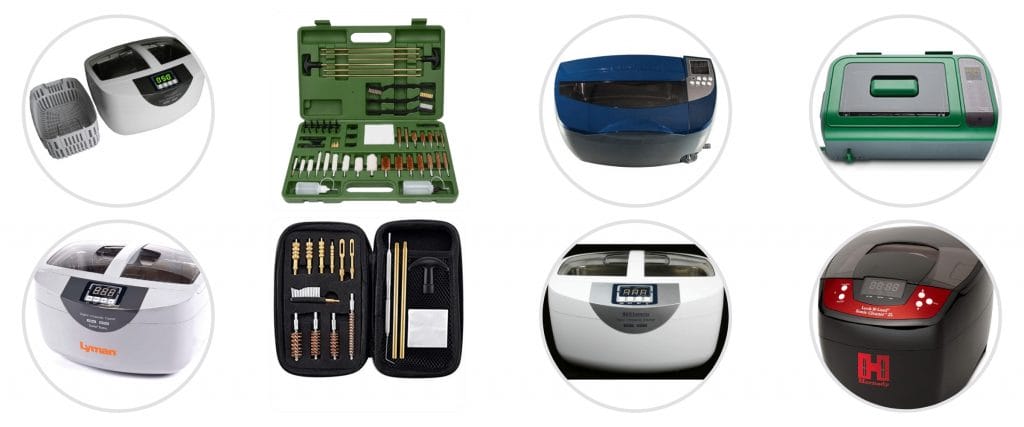Ultrasonic cleaning devices represent the pinnacle of cleaning technology, effectively eliminating dirt and debris from the most intricate designs. This article delves into the mechanics of ultrasonic technology for cleaning and the innovative technologies that enable its effectiveness. Additionally, we will highlight three exemplary products that showcase the extraordinary cleaning power of ultrasonic cleaners.
How Ultrasonic Waves for Cleaning are Produced?
Ultrasonic waves are produced when high-frequency sound waves traverse through a cleaning fluid, typically water mixed with a suitable detergent. This interaction leads to the formation of millions of microscopic bubbles in a phenomenon known as ultrasonic cavitation. These bubbles, born from the stretching and compressing phases of the sound waves in the fluid, implode under the mechanical action of the ultrasonic waves. This implosion releases substantial energy and raises the local temperature. The process drives these bubbles into tiny crevices, allowing the fluid to dislodge contaminants from the surface of the object, ensuring a thorough clean free from hidden soils.
Understanding the Range of Ultrasonic Frequencies
25 kHz: High Power for Tough Contaminants
- Application: Ideal for removing strong pollution, similar to the challenges addressed in Best Ultrasonic Cleaning Solution for Suppressors.
- Caution: Avoid use on mirror-polished surfaces and delicate materials like glass and aluminum.
40 kHz: The Versatile Standard
- Application: A standard frequency compatible with a wide range of materials, effectively removing various pollutants.
80 kHz: Precision Cleaning for Complex Geometries
- Application: Specifically used for parts with complex shapes. Cavitation bubbles penetrate small holes to eradicate pollution.
120 kHz and Megasonic: For Delicate and Precision Parts
- Application: Primarily used in precision optics for cleaning highly sensitive components like wafers.
- Note: Due to the low power of cavitation, these frequencies are best for final cleaning stages, primarily to remove dust from already clean parts.
How Does Ultrasonic Cleaning Work?
The Core Process of Ultrasonic Cleaners
Ultrasonic cleaners function by utilizing high-frequency sound waves, generally ranging from 20 to 60 kHz. The specific ultrasonic frequency chosen influences the size of the microscopic bubbles generated through cavitation – a process crucial for removing contaminants. Among these frequencies, 45 kHz (45,000 Hz) is especially significant. It offers an ideal balance, providing sufficient cleaning power while ensuring the safety of the objects being cleaned.
Cavitation: The Key to Deep Cleaning
As the ultrasonic vibrations of sound waves propagate through water or a specialized cleaning solution, they initiate cavitation, forming tiny bubbles. These bubbles expand until they can no longer hold more energy from the surrounding liquid. When they reach their maximum capacity, they implode against the surface of the item being cleaned. This implosion results in shock waves that effectively dislodge dirt and other contaminants, a process thoroughly explained in Ultrasonic Firearm Cleaning Techniques.
How Bubbles Enhance Cleaning Efficiency
The continuous formation and collapse of these bubbles act like a microscopic scrubbing mechanism. This process allows for deep cleaning of the object, reaching even the most inaccessible areas, ensuring a thorough and efficient cleaning outcome.
Key Parameters Influencing Cavitation in Ultrasonic Cleaning
External Pressure and Its Impact on Cavitation
The external pressure applied during ultrasonic cleaning can significantly affect the cavitation process. Adjusting this pressure can alter the intensity and effectiveness of the ultrasonic cleaning machine.
Temperature: Enhancing Cleaning Efficiency
Heating the cleaning liquid can considerably reduce cleaning time, as warmer temperatures facilitate faster dirt removal. The optimal temperature for each cleaning process depends on the specific type of dirt and the object being cleaned.
Ultrasound Frequency and Power: Tailoring to Cleaning Needs
The frequency and power of ultrasound waves are crucial in determining the cleaning effectiveness. Different materials and types of dirt may require specific frequencies and power levels of sound wave for optimal cleaning results.
Chemical Composition: A Critical Factor
The nature, concentration, and density of the chemicals used in the cleaning solution play a vital role in the cleaning process. Selecting the right chemical composition is essential for effective and safe industrial cleaning, especially for delicate or sensitive materials.
Ultrasonic Waves: The Driving Force
Ultrasonic waves are at the heart of the cleaning process, creating cavitation that helps remove dirt. The quality and pattern of these waves can influence the cleaning outcome.
Optimal Positioning of Parts in the Ultrasonic Cleaner
The Importance of Positioning for Complex Geometries
Positioning of parts within the ultrasonic cleaning chamber is critical, especially for items with complex geometries. Proper positioning ensures that all surfaces are adequately exposed to the cleaning solution and ultrasound waves.
Advantages of Correct Part Positioning
- Enhanced Ultrasonic Efficiency: Properly positioned parts ensure optimal exposure to the ultrasonic waves, whether through dipping or pressure jet spraying.
- Protection Against Mechanical Damage: Correct positioning minimizes the risk of mechanical damage to the surface of the parts being cleaned.
- Improved Contact with Cleaning Agents: Ensuring the right orientation and spacing allows for more effective contact between the substrate and the chemical agents in the cleaning solution.
- Rinsing and Drying Efficiency: Proper positioning also impacts the efficiency of subsequent rinsing and drying steps, ensuring that no residues are left and that parts dry uniformly.
Key Benefits of Ultrasonic Cleaning Technology
Precision Cleaning for Complex Items
Ultrasonic cleaners excel in cleaning objects with intricate designs and hard-to-reach areas. Their effectiveness makes them particularly suitable for items like jewelry and eyeglasses, which often feature complex details.
Gentle Yet Powerful Cleaning for Delicate Objects
These cleaners are robust enough to tackle tough dirt and grime while being gentle on delicate items. This attribute is essential for safely cleaning fragile objects such as earrings or antique jewelry, ensuring they are cleansed thoroughly without risking damage.
Efficiency and Convenience for the Time-Conscious
Ultrasonic cleaning is both quick and user-friendly. Multiple cleaning cycles can be completed in just a few minutes, making these cleaners a convenient option for individuals with busy schedules who need efficient cleaning solutions.
Environmentally Conscious Cleaning Solution
Ultrasonic cleaners are an eco-friendly choice. They primarily use water and, if needed, a small quantity of mild cleaning solution. This significantly reduces the reliance on harsh chemicals, thereby minimizing the environmental footprint of the cleaning process.
Best Practices for Selecting Cleaning Solutions in Ultrasonic Cleaning
The Crucial Role of the Cleaning Solution
The effectiveness of ultrasonic cleaning is significantly influenced by the choice of cleaning solution. Plain water alone falls short in this process. Specialized cleaning solutions are formulated to enhance the ultrasonic cleaning process, containing components that lower surface tension and boost cavitation, such as effective wetting agents or surfactants.
Aqueous Solutions: The Standard in Ultrasonic Cleaning
Aqueous cleaning solutions, which include detergents and wetting agents, are commonly used in ultrasonic cleaning. These ingredients are pivotal in the cleaning process. The specific composition of these solutions should be tailored to the type of object being cleaned. Typically, these solutions are used warm, between 50–65 °C (122–149 °F), to maximize their cleaning efficacy.
Water-Based vs. Solvent Solutions: A Comparative Analysis
While water-based solutions are prevalent in medical applications, they may not be as effective as solvent solutions in removing certain contaminants through chemical action alone. In cases of delicate parts coated with thick grease, solvent solutions may prove more efficient. Designing an effective aqueous cleaning system for specific cleaning needs often requires more effort than a solvent-based system.
Safety Considerations in Ultrasonic Cleaning
It is crucial to note that HFE 7100, a specific type of solvent, should never be used in ultrasonic tanks. Its high rate of solvent loss can not only damage surfaces but also pose risks to the user. Ensuring the right choice of cleaning solution is not just about effectiveness but also about safety and equipment longevity.
Choosing the Right Ultrasonic Cleaners
When selecting an ultrasonic cleaner, it’s essential to differentiate between high-quality machines and those that are simply “off-the-shelf” products. The advent of global manufacturing and online shopping has introduced a variety of ultrasonic cleaners to the market, often at lower prices. However, these cost savings frequently come at the expense of quality, as discussed in Best Ultrasonic Cleaner for Carburetors. Many users, unaware of these quality compromises, opt for cheaper models, mistakenly believing they are equivalent to higher-end, U.S.-made ultrasonic cleaners. This assumption is far from reality. Following are some key features that you should look for in your ultrasonic cleaner.
The Variability of Piezoelectric Crystal Transducers
The quality of piezoelectric crystal transducers can vary significantly. Even high-quality transducers naturally degrade over time (typically 3-6 years), affecting their ability to convert electrical energy into mechanical/sound energy. Lower-quality transducers deteriorate much faster, impacting the cleaning effectiveness of the machine. Some ultrasonic cleaners might perform well initially but can show diminished cleaning ability within just 3-6 months.
Ultrasonic Generators: The Heart of the Machine
The components of ultrasonic generators in cheaper models may not have the expected longevity. This, combined with faster transducer decay, can lead to significant performance variations over time, leading to increased scrapped parts and rework, posing cost issues and failing to meet validation protocols in critical industries like medical devices and aerospace.
The Impact of Low-Powered Transducers
Opting for low-powered transducers can reduce the initial cost of the machine but at the expense of cleaning effectiveness. These transducers may struggle to cavitate the cleaning solution evenly, compromising the cleaning process.
The Importance of Tank Thickness
The frequency of ultrasonic energy application can gradually erode the tank. Signs of erosion include a gray appearance on stainless steel and pits at the bottom of the tank. Low-quality cleaners often use thinner stainless steel, leading to visible wear within months.
How to Prevent Ultrasonic Cleaning Damage?
Preventing Damage Through Proper Item Placement
In ultrasonic cleaning, it’s crucial to avoid placing items directly at the bottom of the tank. This is because cavitation—the creation and bursting of tiny bubbles in the cleaning solution—can’t occur effectively on parts of the object that don’t make contact with the solvent. Lack of cavitation can lead to poor cleaning results and potentially damage the item.
The Importance of Not Overcrowding the Cleaning Space
It’s essential not to stack items during the cleaning process. Each part requires sufficient space around it to allow for uniform cavitation and to prevent damage from the vibration of parts against each other. Overcrowding or stacking can lead to uneven cleaning and the risk of items becoming adhered to each other, resulting in damage.
Utilizing Baskets and Jigs for Enhanced Safety and Efficiency
To further minimize the risk of damage and optimize the cleaning process, using baskets and jigs is highly recommended. These tools help keep the items separate, preventing them from touching each other, and ensure maximum exposure to the cleaning solution. This approach not only enhances cleaning effectiveness but also safeguards the items from potential harm.
Conclusion
Ultrasonic cleaning stands as a highly effective and environmentally friendly method for cleaning a wide range of objects. From intricate jewelry to precision mechanical parts, this technology offers a solution that is both gentle and powerful, like the systems described in Best Ultrasonic Cleaner for Guns. Understanding the key parameters such as the choice of cleaning solution, the temperature and frequency of the ultrasonic waves, as well as the positioning of items within the cleaner, is crucial for achieving optimal results.
As we have explored, the successful application of ultrasonic cleaning lies not just in the technology itself, but also in the understanding and application of the various factors that contribute to its effectiveness. By adhering to best practices and understanding the underlying chemistry and physics of ultrasonic action, users can maximize the benefits of ultrasonic cleaning, ensuring thorough, efficient, and safe cleaning for a wide array of items. This technology, with its combination of effectiveness and environmental friendliness, represents a significant advancement in cleaning methodologies, offering both professional and personal users a superior cleaning solution.











